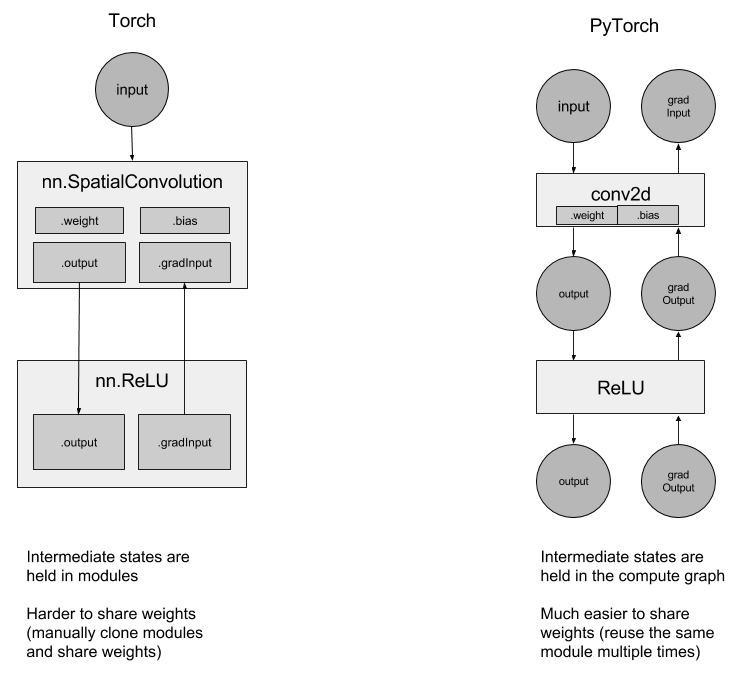nn package
译者:@unknown
校对者:@bringtree
我们重新设计了 nn package, 以便与 autograd 完全集成. 让我们来回顾一下这些变化.
用 autograd 替换 containers:
你不再需要使用像
ConcatTable这样的 Containers, 或者像CAddTable这样的模块, 或者使用 nngraph 并且 debug. 我们将无缝地使用 autograd 来定义我们的神经网络. 例如,
output = nn.CAddTable():forward({input1, input2})简化为output = input1 + input2output = nn.MulConstant(0.5):forward(input)简化为output = input * 0.5
中间状态不再存放在上述提到的那些模块中, 而是存放在计算图中:
因为这个原因, 所以使用循环网络变得更加简单. 如果你想创建一个循环网络, 只需多次使用相同的 Linear 层, 而不必考虑共享权重.
torch-nn-vs-pytorch-nn
Simplified debugging:
使用Python的pdb调试器进行调试是直观的, 调试器和堆栈跟踪在发生错误的地方停止. What you see is what you get(所见即所得, 译者注:应该是说可视化吧).
Example 1: ConvNet
让我们来创建一个小的 ConvNet.
你所有的网络都来自 nn.Module 基类:
- 在构造函数中, 声明你想要使用的所有层.
- 在 forward 函数中, 你可以定义模型从输入到输出将如何运行
import torchfrom torch.autograd import Variableimport torch.nn as nnimport torch.nn.functional as Fclass MNISTConvNet(nn.Module):def __init__(self):# 这是你实例化所有模块的地方# 你可以稍后使用你在此给出的相同名称访问它们super(MNISTConvNet, self).__init__()self.conv1 = nn.Conv2d(1, 10, 5)self.pool1 = nn.MaxPool2d(2, 2)self.conv2 = nn.Conv2d(10, 20, 5)self.pool2 = nn.MaxPool2d(2, 2)self.fc1 = nn.Linear(320, 50)self.fc2 = nn.Linear(50, 10)# 这是 forward 函数, 它定义了只接受一个输入的网络结构,# 如果你愿意, 可以随意定义支持使用更多输入的网络结构.def forward(self, input):x = self.pool1(F.relu(self.conv1(input)))x = self.pool2(F.relu(self.conv2(x)))# 在你的创建模型的过程中, 你可以疯狂地使用任意的python代码创建你的模型结构,# 这些操作都是完全合法的, 并且会被autograd正确处理:# if x.gt(0) > x.numel() / 2:# ...## 你甚至可以做一个循环来重复使用相同的模块, 模块内部的模块不再# 处于临时状态, 所以你可以在 forward 时多次使用它们.# while x.norm(2) < 10:# x = self.conv1(x)x = x.view(x.size(0), -1)x = F.relu(self.fc1(x))x = F.relu(self.fc2(x))return x
现在让我们来使用定义好的 ConvNet. 你应该先创建一个类的实例.
net = MNISTConvNet()print(net)
注解:
torch.nn 只支持 mini-batches , 整个 torch.nn package 只支持输入 mini-batch 格式的样本, 而不支持输入单个样本.
例如, nn.Conv2d 将采用 nSamples x nChannels x Height x Width 的 4D Tensor.
如果你有一个单个的样本, 只需使用 input.unsqueeze(0) 添加一个 虚假的 batch 维度.
创建一个包含随机数据的单个样本的 mini-batch, 并将该样本传入到 ConvNet .
input = Variable(torch.randn(1, 1, 28, 28))out = net(input)print(out.size())
定义一个虚拟目标标签, 并使用损失函数来计算 error.
target = Variable(torch.LongTensor([3]))loss_fn = nn.CrossEntropyLoss() # LogSoftmax + ClassNLL Losserr = loss_fn(out, target)err.backward()print(err)
ConvNet 的 out 是一个 Variable. 我们使用它来计算损失, 计算结果 err 也是一个 Variable. 调用 err 的 .backward 方法将会通过 ConvNet 将梯度传播到它的权重.
让我们来访问单个层的权重和梯度:
print(net.conv1.weight.grad.size())
print(net.conv1.weight.data.norm()) # norm of the weightprint(net.conv1.weight.grad.data.norm()) # norm of the gradients
Forward and Backward Function Hooks
我们已经检查了权重和梯度. 但是如何检查 / 修改一个层的输出和 grad_output?
我们为此引出了 hooks.
你可以在一个 Module 或一个 Variable 上注册一个函数. hook 可以是 forward hook 也可以是一个 backward hook. 当 forward 被执行后 forward hook 将会被执行. backward hook 将在执行 backward 阶段被执行. 让我们来看一个例子.
我们在 conv2 注册一个 forward hook 来打印一些信息
def printnorm(self, input, output):# input是将输入打包成的 tuple 的input# 输出是一个 Variable. output.data 是我们感兴趣的 Tensorprint('Inside ' + self.__class__.__name__ + ' forward')print('')print('input: ', type(input))print('input[0]: ', type(input[0]))print('output: ', type(output))print('')print('input size:', input[0].size())print('output size:', output.data.size())print('output norm:', output.data.norm())net.conv2.register_forward_hook(printnorm)out = net(input)
我们在 conv2 注册一个 backward hook 来打印一些信息
def printgradnorm(self, grad_input, grad_output):print('Inside ' + self.__class__.__name__ + ' backward')print('Inside class:' + self.__class__.__name__)print('')print('grad_input: ', type(grad_input))print('grad_input[0]: ', type(grad_input[0]))print('grad_output: ', type(grad_output))print('grad_output[0]: ', type(grad_output[0]))print('')print('grad_input size:', grad_input[0].size())print('grad_output size:', grad_output[0].size())print('grad_input norm:', grad_input[0].data.norm())net.conv2.register_backward_hook(printgradnorm)out = net(input)err = loss_fn(out, target)err.backward()
一个完整的可以运行的 MNIST 例子在此链接中 https://github.com/pytorch/examples/tree/master/mnist
Example 2: Recurrent Net
接下来, 让我们看一下用 PyTorch 创建 recurrent nets.
由于网络的状态是保存在图中, 而不是在 layer 中, 所以您可以简单地 创建一个 nn.Linear 并重复使用它.
class RNN(nn.Module):# 你也可以在你模型的构造函数中传入参数def __init__(self, data_size, hidden_size, output_size):super(RNN, self).__init__()self.hidden_size = hidden_sizeinput_size = data_size + hidden_sizeself.i2h = nn.Linear(input_size, hidden_size)self.h2o = nn.Linear(hidden_size, output_size)def forward(self, data, last_hidden):input = torch.cat((data, last_hidden), 1)hidden = self.i2h(input)output = self.h2o(hidden)return hidden, outputrnn = RNN(50, 20, 10)
更完整的使用 LSTMs 和 Penn Tree-bank 的语言模型位于 here
PyTorch 默认已经为 ConvNets 和 Recurrent Nets 提供了无缝的 CuDNN 集成.
loss_fn = nn.MSELoss()batch_size = 10TIMESTEPS = 5# 创建一些假数据batch = Variable(torch.randn(batch_size, 50))hidden = Variable(torch.zeros(batch_size, 20))target = Variable(torch.zeros(batch_size, 10))loss = 0for t in range(TIMESTEPS):# 是的! 你可以多次使用同一个网络,# 将损失相加, 并且调用 call backward!hidden, output = rnn(batch, hidden)loss += loss_fn(output, target)loss.backward()


